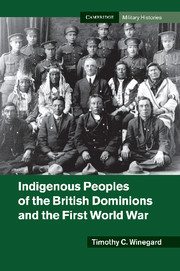Book contents
- Frontmatter
- Contents
- Figures
- Maps
- Tables
- Acknowledgements
- Note on the text
- Introduction
- 1 Colonization and the settler state
- 2 Racial constructs and martial theories
- 3 Precedents of military pragmatism
- 4 Dominion defence acts
- 5 1914: Subjugated spectators
- 6 1915–1916: King and country call
- 7 1917–1918: All the King’s men
- 8 Indigenous soldiers
- 9 The home front
- 10 Peace with prejudice
- Conclusion
- Bibliography
- Index
- References
9 - The home front
Published online by Cambridge University Press: 05 June 2014
- Frontmatter
- Contents
- Figures
- Maps
- Tables
- Acknowledgements
- Note on the text
- Introduction
- 1 Colonization and the settler state
- 2 Racial constructs and martial theories
- 3 Precedents of military pragmatism
- 4 Dominion defence acts
- 5 1914: Subjugated spectators
- 6 1915–1916: King and country call
- 7 1917–1918: All the King’s men
- 8 Indigenous soldiers
- 9 The home front
- 10 Peace with prejudice
- Conclusion
- Bibliography
- Index
- References
Summary
The enthusiasm for the war effort among indigenes was evident within indigenous communities on the home fronts and was shared by women as well as men. Indigenous women served as nurses and were active in patriotic organizations. Indigenous peoples donated money to war funds and contributed to the agricultural and industrial output of the Dominions. Edith Montour, of the Six Nations Reserve, served as a nurse with the US Medical Corps. By 1917, she was stationed in Vittel, France, treating wounded soldiers: ‘Sometimes we would walk right over to where there had been fighting. It was an awful sight … whole towns blow[n] up’. Fourteen American Indian women served as nurses. An unknown number of Maori nurses were also present in New Zealand field hospitals. Allen wrote to Pomare on 3 September 1915 that, ‘I have already authorized the Commandant to secure a certain number of Maori nurses for the front.’ However, he stipulated that, ‘I do not deem it prudent to let them go except under the charge of an experienced pakeha matron or nurse.’ While no black South African nurses accompanied the SANLC to Europe, they were present in black veteran hospitals in the Union itself. In April 1916, the Ministry of Native Affairs made this recommendation: ‘Since Native nurses are required for work solely amongst Natives, which there is no prospect of White nurses ever undertaking and which it is undesirable White nurses should undertake, the establishment of a Junior Certificate for Natives would not appear in any way to endanger the prestige of the nursing profession generally or to discourage Natives from aspiring to the European nursing standard.’
The greatest contribution made by indigenous women was on the home front through patriotic organizations. Maori women were active in national war organizations, as well as Maori-specific associations, such as ‘Lady Liverpool’s and Mrs. Pomare’s Maori Soldiers’ Fund’. In 1917, Maori leaders, doubting the government’s sincerity in proposing equality in repatriation programmes, set up the Maori Patriotic Committee to raise private funds among Maori. The money was used for the welfare of Maori veterans. The possibility of buying land for veterans was considered but never initiated.
- Type
- Chapter
- Information
- Publisher: Cambridge University PressPrint publication year: 2011



